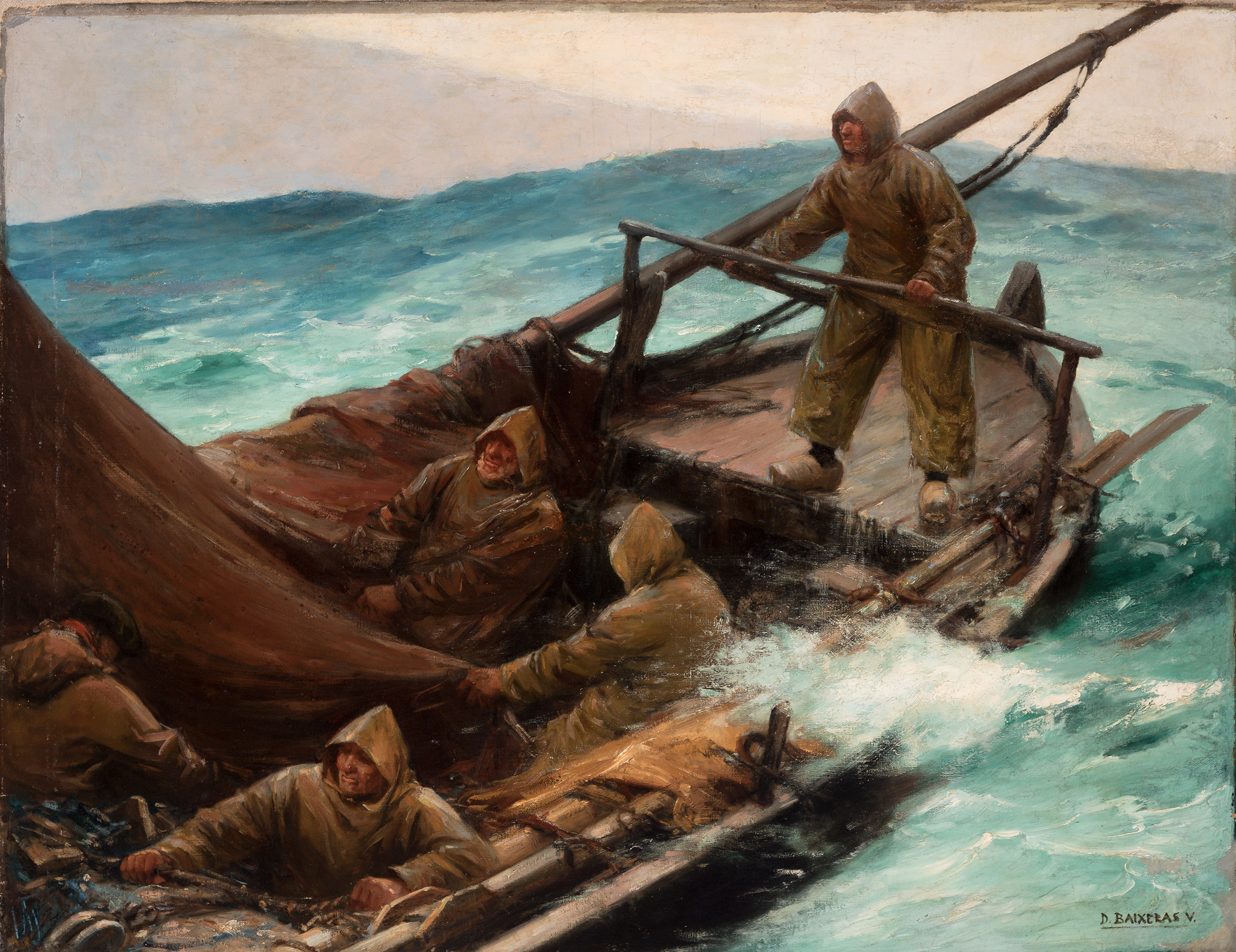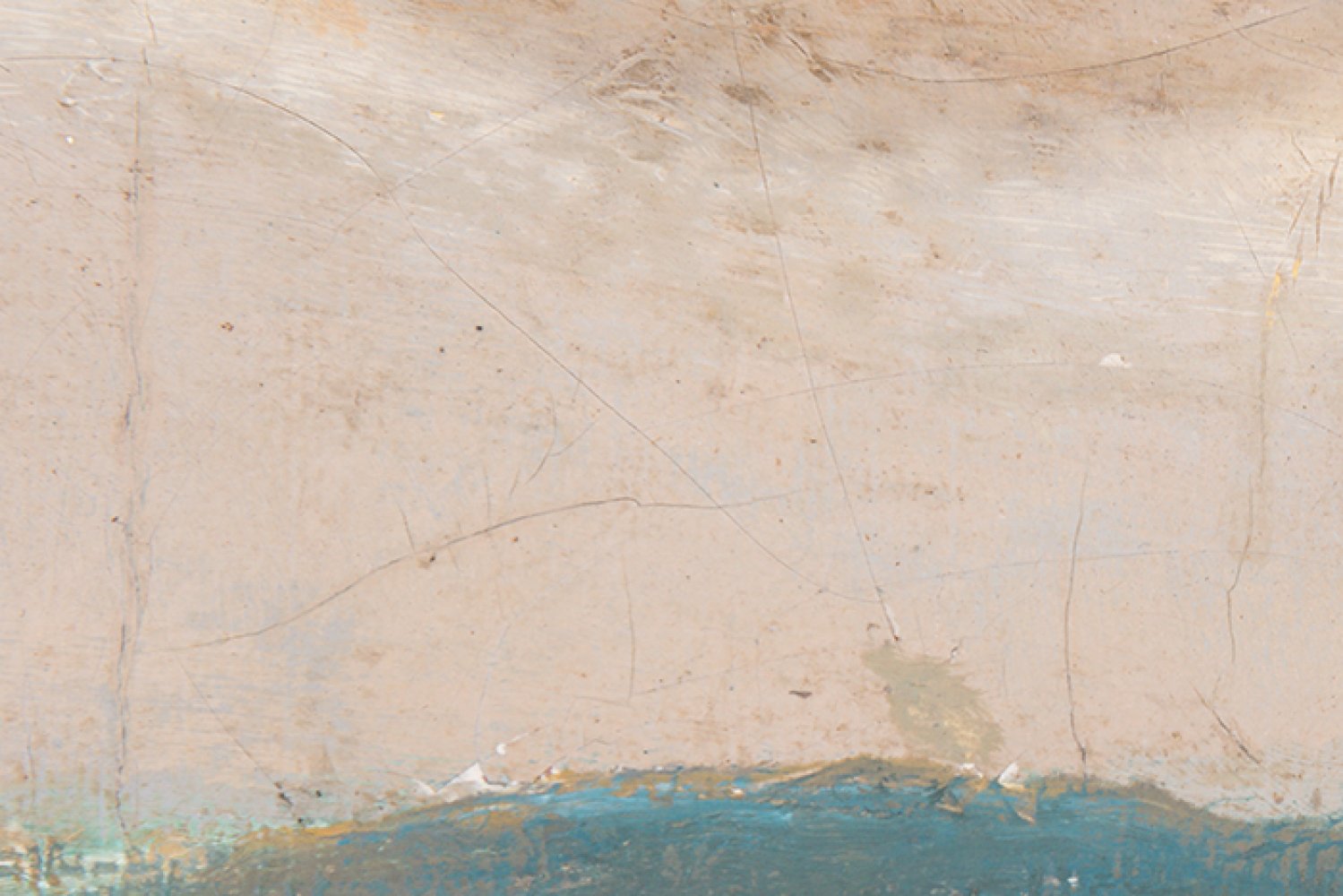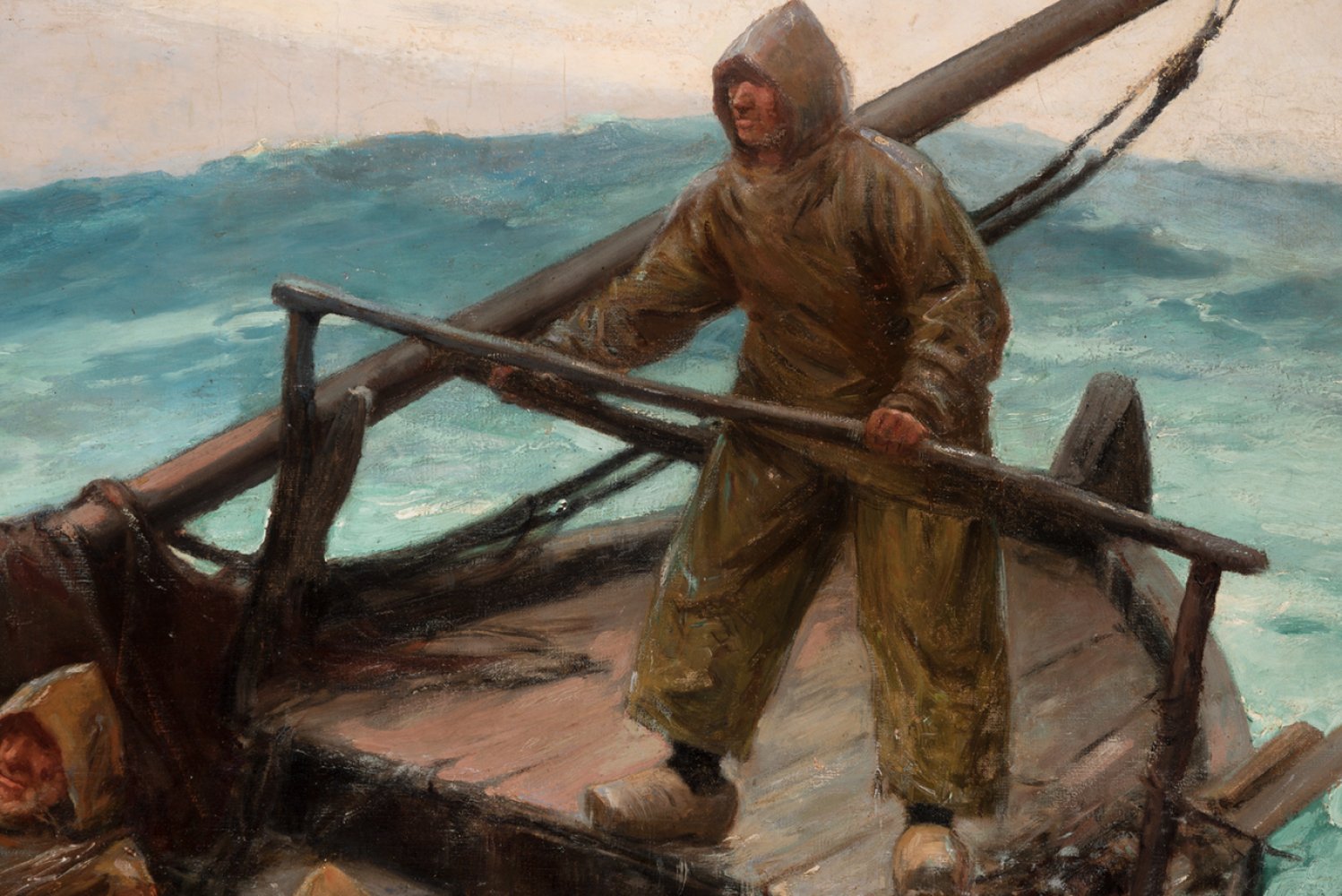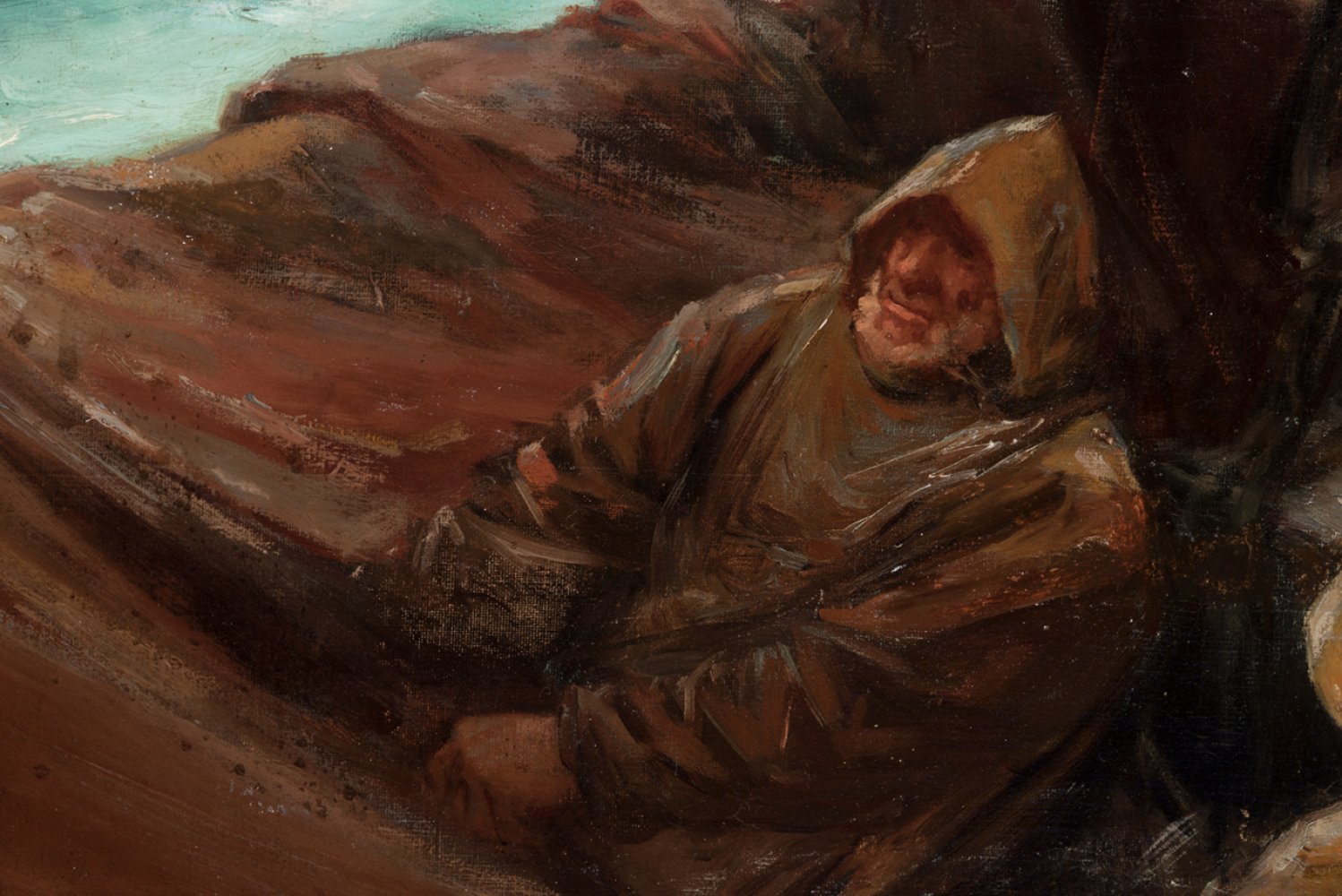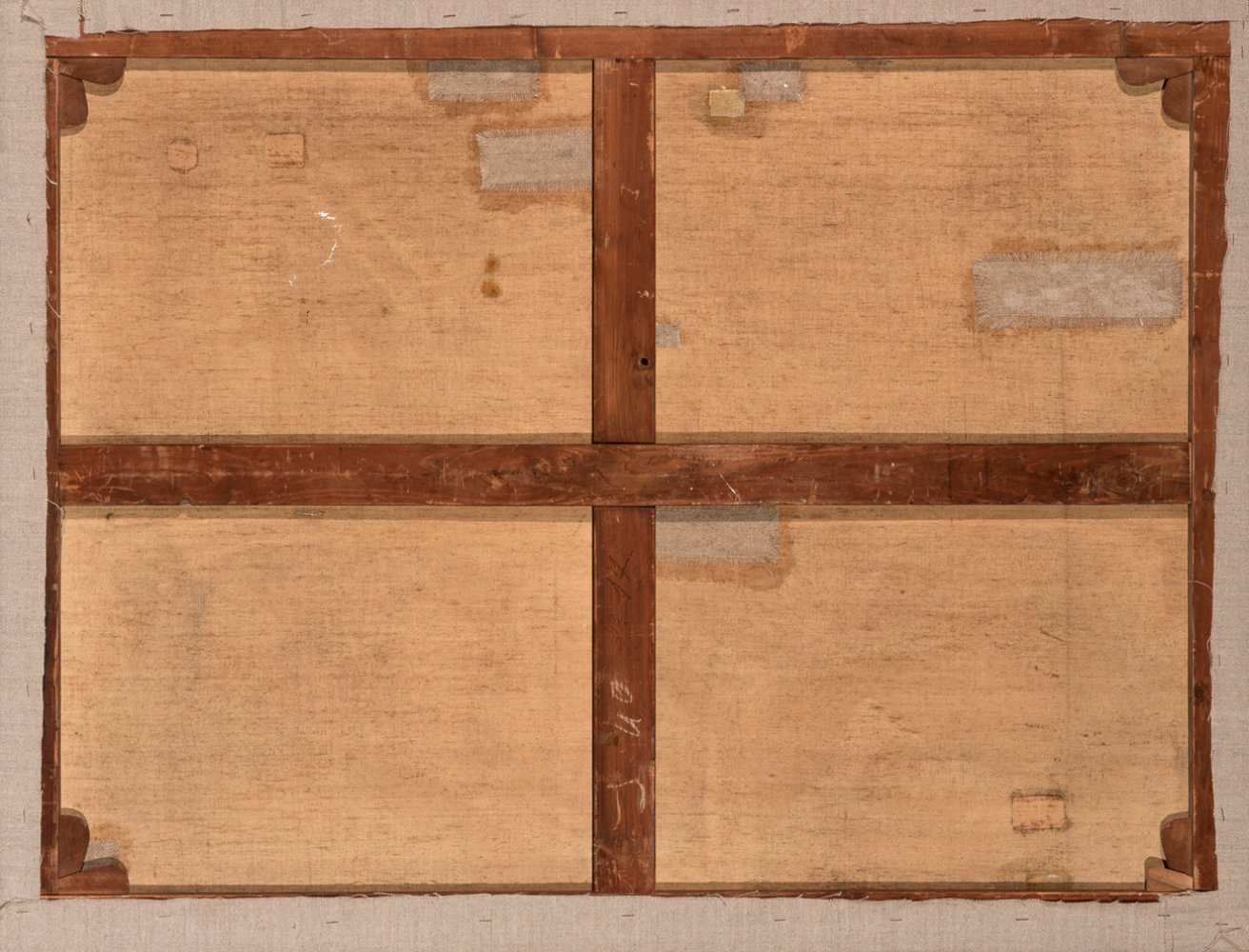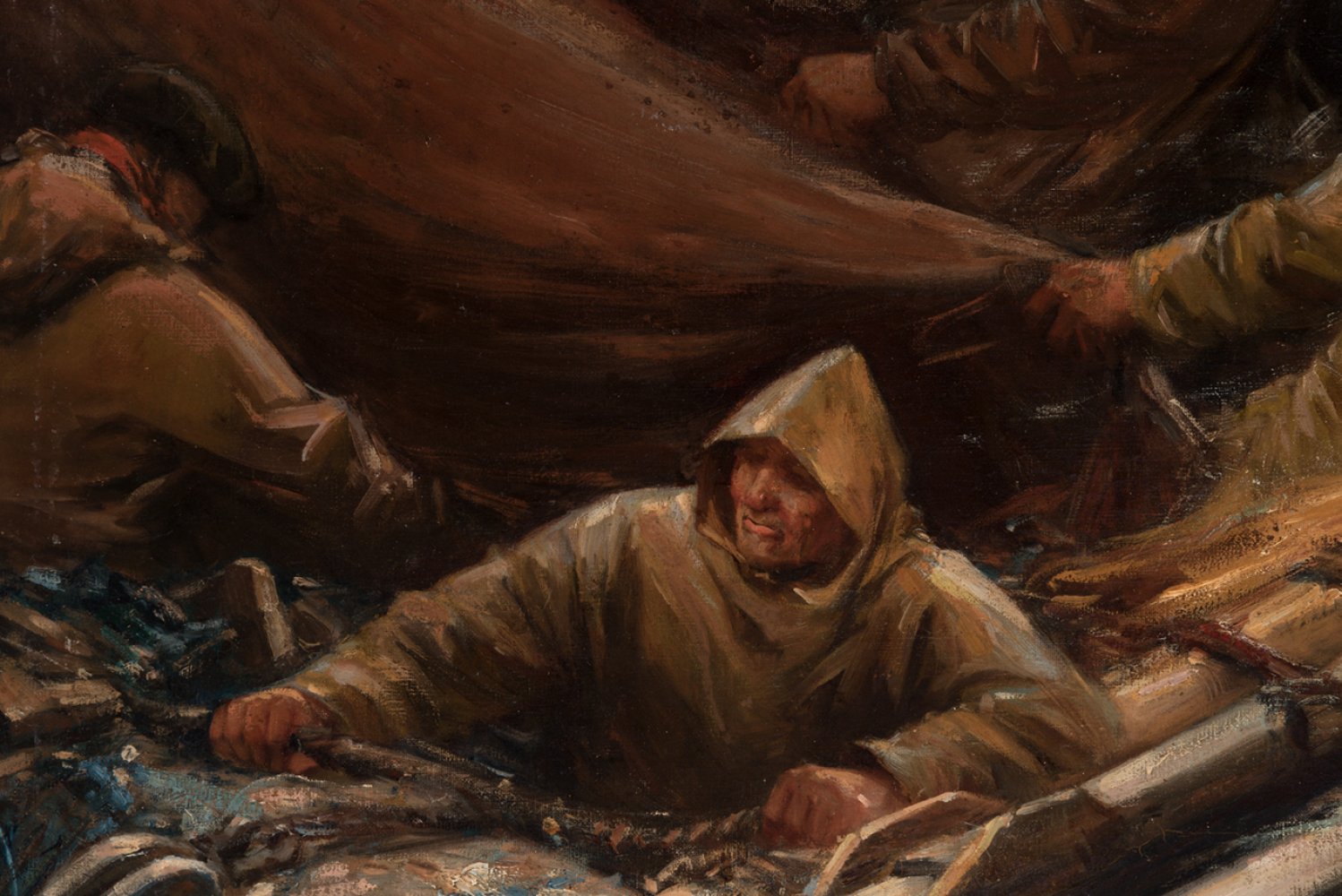12
DIONÍS BAIXERAS VERDAGUER (Barcelona, 1862 - 1943).Untitled.Oil on canvas.With repainting,
1/7
Description
DIONÍS BAIXERAS VERDAGUER (Barcelona, 1862 - 1943).
Untitled.
Oil on canvas.
With repainting, restorations and patches on the back.
Signed in the lower right corner.
Measurements: 89 x 116 cm.
Dionís Baixeras portrays in this canvas an everyday scene of Barcelona in the first half of the 20th century, starring a couple of Catalan children playing by the sea in a seaside town on the coast of Girona. The children are surrounded by a delicate chromaticism captured with a certain lyrical tone, in which they remain oblivious to everything around them, sitting by the water, immersed in their own thoughts. Ultimately, behind a harmonious mass of water worked with the colours of the sunset, the local church rises up. A disciple at the Escuela de la Lonja of Martí Alsina and, above all, of Antonio Caba, during his student years Baixeras was nicknamed "el medallas" ("the medal winner"), due to his facility for winning competitions. He exhibited for the first time in 1882 at the Sala Parés in Barcelona, and four years later he travelled to Paris, where he became enthusiastic about the peasant-themed realism of Millet and Bastien-Lepage. During these years he won awards at the Fine Arts Exhibitions in Madrid (1884, third medal) and Paris (1886, honourable mention). On returning to Barcelona he produced large compositions of a historical nature, such as those of the university auditorium (1888), the seminary (1904, destroyed in 1936) and the dome of the Generalitat's Sant Jordi Hall (1928). In 1907 he produced a series of drawings of a documentary type, centred on depicting the corners of Barcelona that would disappear with the construction of the Via Layetana, which won him a prize from the City Council. In 1926 he joined the Sant Jordi Royal Academy of Fine Arts and was linked to the Círculo Artístico de Sant Lluc from its foundation. During his last years he wrote an interesting memoir, the original manuscript of which is now kept at the Sant Jordi Academy. Baixeras devoted himself mainly to naturalistic painting, with marine or rural themes, in works that show a certain influence of the Olot school. He worked meticulously on his works in his studio, which is why his preliminary drawings are much fresher and more interesting. In 1908 he produced a collection of drawings, of great documentary value, of places in old Barcelona which were to disappear when the Via Layetana was built. His work is preserved in the Metropolitan Museum of Art and Industry in Roubaix (France) and the MACBA, among others.
Untitled.
Oil on canvas.
With repainting, restorations and patches on the back.
Signed in the lower right corner.
Measurements: 89 x 116 cm.
Dionís Baixeras portrays in this canvas an everyday scene of Barcelona in the first half of the 20th century, starring a couple of Catalan children playing by the sea in a seaside town on the coast of Girona. The children are surrounded by a delicate chromaticism captured with a certain lyrical tone, in which they remain oblivious to everything around them, sitting by the water, immersed in their own thoughts. Ultimately, behind a harmonious mass of water worked with the colours of the sunset, the local church rises up. A disciple at the Escuela de la Lonja of Martí Alsina and, above all, of Antonio Caba, during his student years Baixeras was nicknamed "el medallas" ("the medal winner"), due to his facility for winning competitions. He exhibited for the first time in 1882 at the Sala Parés in Barcelona, and four years later he travelled to Paris, where he became enthusiastic about the peasant-themed realism of Millet and Bastien-Lepage. During these years he won awards at the Fine Arts Exhibitions in Madrid (1884, third medal) and Paris (1886, honourable mention). On returning to Barcelona he produced large compositions of a historical nature, such as those of the university auditorium (1888), the seminary (1904, destroyed in 1936) and the dome of the Generalitat's Sant Jordi Hall (1928). In 1907 he produced a series of drawings of a documentary type, centred on depicting the corners of Barcelona that would disappear with the construction of the Via Layetana, which won him a prize from the City Council. In 1926 he joined the Sant Jordi Royal Academy of Fine Arts and was linked to the Círculo Artístico de Sant Lluc from its foundation. During his last years he wrote an interesting memoir, the original manuscript of which is now kept at the Sant Jordi Academy. Baixeras devoted himself mainly to naturalistic painting, with marine or rural themes, in works that show a certain influence of the Olot school. He worked meticulously on his works in his studio, which is why his preliminary drawings are much fresher and more interesting. In 1908 he produced a collection of drawings, of great documentary value, of places in old Barcelona which were to disappear when the Via Layetana was built. His work is preserved in the Metropolitan Museum of Art and Industry in Roubaix (France) and the MACBA, among others.
Auction Details
Shipping
T&Cs & Important Info
Ask seller a question
DIONÍS BAIXERAS VERDAGUER (Barcelona, 1862 - 1943).
Untitled.
Oil on canvas.
With repainting, restorations and patches on the back.
Signed in the lower right corner.
Measurements: 89 x 116 cm.
Dionís Baixeras portrays in this canvas an everyday scene of Barcelona in the first half of the 20th century, starring a couple of Catalan children playing by the sea in a seaside town on the coast of Girona. The children are surrounded by a delicate chromaticism captured with a certain lyrical tone, in which they remain oblivious to everything around them, sitting by the water, immersed in their own thoughts. Ultimately, behind a harmonious mass of water worked with the colours of the sunset, the local church rises up. A disciple at the Escuela de la Lonja of Martí Alsina and, above all, of Antonio Caba, during his student years Baixeras was nicknamed "el medallas" ("the medal winner"), due to his facility for winning competitions. He exhibited for the first time in 1882 at the Sala Parés in Barcelona, and four years later he travelled to Paris, where he became enthusiastic about the peasant-themed realism of Millet and Bastien-Lepage. During these years he won awards at the Fine Arts Exhibitions in Madrid (1884, third medal) and Paris (1886, honourable mention). On returning to Barcelona he produced large compositions of a historical nature, such as those of the university auditorium (1888), the seminary (1904, destroyed in 1936) and the dome of the Generalitat's Sant Jordi Hall (1928). In 1907 he produced a series of drawings of a documentary type, centred on depicting the corners of Barcelona that would disappear with the construction of the Via Layetana, which won him a prize from the City Council. In 1926 he joined the Sant Jordi Royal Academy of Fine Arts and was linked to the Círculo Artístico de Sant Lluc from its foundation. During his last years he wrote an interesting memoir, the original manuscript of which is now kept at the Sant Jordi Academy. Baixeras devoted himself mainly to naturalistic painting, with marine or rural themes, in works that show a certain influence of the Olot school. He worked meticulously on his works in his studio, which is why his preliminary drawings are much fresher and more interesting. In 1908 he produced a collection of drawings, of great documentary value, of places in old Barcelona which were to disappear when the Via Layetana was built. His work is preserved in the Metropolitan Museum of Art and Industry in Roubaix (France) and the MACBA, among others.
Untitled.
Oil on canvas.
With repainting, restorations and patches on the back.
Signed in the lower right corner.
Measurements: 89 x 116 cm.
Dionís Baixeras portrays in this canvas an everyday scene of Barcelona in the first half of the 20th century, starring a couple of Catalan children playing by the sea in a seaside town on the coast of Girona. The children are surrounded by a delicate chromaticism captured with a certain lyrical tone, in which they remain oblivious to everything around them, sitting by the water, immersed in their own thoughts. Ultimately, behind a harmonious mass of water worked with the colours of the sunset, the local church rises up. A disciple at the Escuela de la Lonja of Martí Alsina and, above all, of Antonio Caba, during his student years Baixeras was nicknamed "el medallas" ("the medal winner"), due to his facility for winning competitions. He exhibited for the first time in 1882 at the Sala Parés in Barcelona, and four years later he travelled to Paris, where he became enthusiastic about the peasant-themed realism of Millet and Bastien-Lepage. During these years he won awards at the Fine Arts Exhibitions in Madrid (1884, third medal) and Paris (1886, honourable mention). On returning to Barcelona he produced large compositions of a historical nature, such as those of the university auditorium (1888), the seminary (1904, destroyed in 1936) and the dome of the Generalitat's Sant Jordi Hall (1928). In 1907 he produced a series of drawings of a documentary type, centred on depicting the corners of Barcelona that would disappear with the construction of the Via Layetana, which won him a prize from the City Council. In 1926 he joined the Sant Jordi Royal Academy of Fine Arts and was linked to the Círculo Artístico de Sant Lluc from its foundation. During his last years he wrote an interesting memoir, the original manuscript of which is now kept at the Sant Jordi Academy. Baixeras devoted himself mainly to naturalistic painting, with marine or rural themes, in works that show a certain influence of the Olot school. He worked meticulously on his works in his studio, which is why his preliminary drawings are much fresher and more interesting. In 1908 he produced a collection of drawings, of great documentary value, of places in old Barcelona which were to disappear when the Via Layetana was built. His work is preserved in the Metropolitan Museum of Art and Industry in Roubaix (France) and the MACBA, among others.
31st August -19th & 20th Century Arts
Sale Date(s)
Venue Address
Aragón 346, Barcelona
Calle Velázquez 7, Madrid
Carrer de Cirilo Amorós 55, Valencia
Barcelona
08009
Spain
General delivery information available from the auctioneer
Setdart offers Worldwide shipping
PICK UP IN ROOM: You can come and pick up your lots in our offices (Barcelona, Madrid or Valencia). At the moment of the withdrawal, you will be able to accept the current conditions of the lot by means of a document that you will sign.
YOU CAN SEND ANOTHER PERSON TO PICK UP: This person must present a signed authorization that you can find in our web page by accessing from BUY AT SETDART- LOGISTICS-DOWNLOAD AUTHORIZATION DOCUMENT. You can also send an e-mail with the requested data in AUTHORIZATION DOCUMENT to admin@setdart.com
Important Information
25% buyer´s premium
21% buyer´s premium at www.setdart.com















